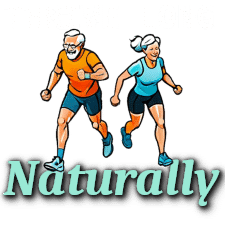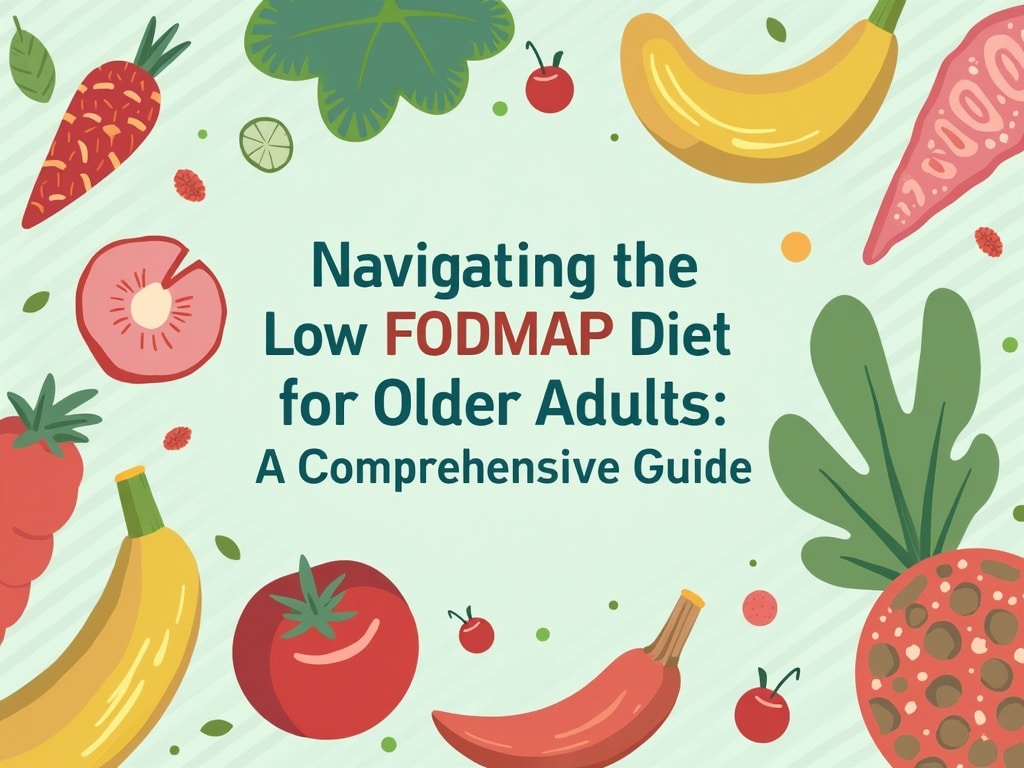Navigating the Low FODMAP Diet for Older Adults: A Comprehensive Guide
As we age, our bodies change, and so do our digestive systems. Suddenly, foods you once enjoyed without a second thought might trigger uncomfortable symptoms like bloating, gas, and abdominal pain. For older adults, these issues can significantly impact quality of life. The low FODMAP diet is increasingly recognized as a potential solution for managing these digestive woes, but navigating this dietary approach requires careful consideration and informed choices, especially for seniors.
Understanding FODMAPs: What Are They?
FODMAP stands for Fermentable Oligosaccharides, Disaccharides, Monosaccharides, and Polyols. These are short-chain carbohydrates that are poorly absorbed in the small intestine. Instead of being absorbed, they travel to the large intestine, where they are fermented by gut bacteria. This fermentation process can produce gas, leading to bloating, distension, and discomfort. In individuals with sensitive guts, particularly those with Irritable Bowel Syndrome (IBS), this can trigger a cascade of unpleasant symptoms.
- Oligosaccharides: These include fructans (found in wheat, onions, garlic) and galactans (found in legumes).
- Disaccharides: Lactose, found in dairy products, is the primary culprit here.
- Monosaccharides: Fructose, found in high amounts in some fruits (like apples and pears) and honey.
- Polyols: These include sugar alcohols like sorbitol, mannitol, xylitol, and maltitol, often found in sugar-free products and some fruits (like avocados and stone fruits).
Why Older Adults Might Benefit from a Low FODMAP Diet
Several age-related factors can contribute to digestive issues that might make a low FODMAP diet beneficial for older adults:
- Decreased Digestive Enzyme Production: As we age, our bodies may produce fewer digestive enzymes, making it harder to break down certain foods, including FODMAPs.
- Slower Gut Motility: The speed at which food moves through the digestive tract can slow down with age, allowing more time for fermentation and gas production.
- Changes in Gut Microbiota: The composition of gut bacteria changes with age, and these changes can affect how FODMAPs are processed.
- Increased Prevalence of Medical Conditions: Older adults are more likely to have medical conditions, such as IBS or small intestinal bacterial overgrowth (SIBO), that can be exacerbated by FODMAPs.
- Medication Use: Many medications commonly used by older adults can affect gut function and contribute to digestive symptoms.
Implementing the Low FODMAP Diet: A Step-by-Step Approach
The low FODMAP diet isn't meant to be a lifelong restriction for everyone. It's typically implemented in three phases:
- Elimination Phase: This involves strictly limiting high FODMAP foods for 2-6 weeks to see if symptoms improve. This phase is about identifying whether FODMAPs are contributing to your digestive issues.
- Reintroduction Phase: Once symptoms have subsided, you'll systematically reintroduce individual FODMAP groups, one at a time, to identify which FODMAPs trigger your symptoms and in what quantity. This phase is crucial for personalizing your diet.
- Maintenance Phase: This is a long-term, modified diet based on your individual tolerance levels identified during the reintroduction phase. You'll reintroduce FODMAPs that you tolerate well while limiting or avoiding those that trigger symptoms.
Adapting the Diet for Older Adults: Special Considerations
While the general principles of the low FODMAP diet apply to everyone, older adults have unique needs and considerations:
- Nutritional Adequacy: The elimination phase can be restrictive, so it's vital to ensure adequate intake of essential nutrients, especially calcium, vitamin D, and fiber. Consultation with a registered dietitian is highly recommended.
- Medication Interactions: Some low FODMAP food alternatives may interact with medications. Discuss your diet with your doctor or pharmacist to ensure there are no potential interactions.
- Social Isolation: Dietary restrictions can sometimes lead to social isolation, especially for older adults who enjoy meals with friends and family. Plan ahead for social events and learn how to adapt meals while still enjoying social connections.
- Difficulty with Meal Preparation: Older adults may have physical limitations that make meal preparation challenging. Consider pre-prepared low FODMAP meals or seeking assistance with cooking.
- Cognitive Impairment: Following a complex diet like the low FODMAP diet requires good cognitive function. Caregivers may need to assist individuals with cognitive impairment in managing their diet.
Foods to Include and Avoid on a Low FODMAP Diet
Navigating the low FODMAP diet can seem overwhelming at first. Here's a general guideline of foods to include and avoid, keeping in mind that individual tolerances vary:
Foods Typically Allowed on a Low FODMAP Diet:
- Fruits: Bananas, blueberries, cantaloupe, grapes, honeydew melon, kiwi, oranges, strawberries.
- Vegetables: Carrots, celery, cucumber, eggplant, green beans, kale, lettuce, spinach, tomatoes, zucchini.
- Grains: Oats, quinoa, rice (white and brown), corn flour, polenta. Gluten-free bread and pasta are often suitable.
- Protein: Beef, chicken, eggs, fish, pork, tofu.
- Dairy Alternatives: Almond milk, coconut milk, rice milk (check labels for added high FODMAP ingredients). Lactose-free dairy products.
- Nuts and Seeds: Almonds (limited to 10 per serving), chia seeds, flax seeds, macadamia nuts, peanuts, pumpkin seeds, walnuts.
Foods Typically Restricted on a Low FODMAP Diet:
- Fruits: Apples, avocados (in large quantities), cherries, dried fruits, mangoes, pears, peaches, plums, watermelon.
- Vegetables: Artichokes, asparagus, broccoli (in large quantities), Brussels sprouts, cabbage, garlic, leeks, mushrooms, onions, peas.
- Grains: Wheat, rye, barley.
- Legumes: Beans, lentils, chickpeas.
- Dairy: Milk, yogurt, ice cream, soft cheeses (unless lactose-free).
- Sweeteners: High-fructose corn syrup, honey, sorbitol, mannitol, xylitol.

Sample Low FODMAP Meal Plan for Older Adults
Here's a sample one-day meal plan to illustrate how to incorporate low FODMAP foods into a balanced diet for older adults. This is just an example, and individual needs may vary.
- Breakfast: Oatmeal made with almond milk, topped with blueberries and a sprinkle of chia seeds.
- Lunch: Grilled chicken salad with mixed greens, cucumber, carrots, and a lemon-tahini dressing.
- Dinner: Baked salmon with roasted zucchini and mashed sweet potatoes.
- Snacks: Banana, a small handful of almonds, lactose-free yogurt.
The Importance of Professional Guidance
It's crucial to emphasize that the low FODMAP diet is not a one-size-fits-all solution. It’s essential to work with a registered dietitian who specializes in gut health and the low FODMAP diet, especially for older adults. A dietitian can help you:
- Assess your individual needs and medical history.
- Develop a personalized low FODMAP meal plan.
- Ensure adequate nutrient intake during the elimination phase.
- Guide you through the reintroduction phase and identify your trigger foods.
- Provide ongoing support and education.
Additionally, consulting with your physician is vital to rule out any underlying medical conditions that may be contributing to your digestive symptoms. They can also help you manage any medication interactions.
Beyond Diet: Lifestyle Factors for Gut Health in Older Adults
While the low FODMAP diet can be a powerful tool, it's important to remember that gut health is influenced by a variety of lifestyle factors. Here are some additional strategies that can help improve digestive health in older adults:
- Stay Hydrated: Dehydration can contribute to constipation and other digestive issues. Aim for at least 8 glasses of water per day.
- Engage in Regular Physical Activity: Exercise can help stimulate gut motility and reduce bloating. Even gentle activities like walking or chair yoga can be beneficial.
- Manage Stress: Stress can negatively impact gut function. Practice relaxation techniques like deep breathing, meditation, or yoga. Consider talking to a therapist or counselor if you're struggling with stress.
- Eat Mindfully: Pay attention to your food and eat slowly. Chew your food thoroughly to aid digestion.
- Probiotics and Prebiotics: Consider taking a probiotic supplement to help improve the balance of gut bacteria. Prebiotics, which are foods that feed beneficial gut bacteria, can also be helpful. Discuss probiotic and prebiotic use with your doctor or dietitian.
The low FODMAP diet can be a valuable tool for managing digestive symptoms in older adults. However, it's important to approach this dietary approach with caution and seek professional guidance to ensure nutritional adequacy and avoid potential complications. By combining the low FODMAP diet with other lifestyle strategies, older adults can improve their gut health and enjoy a better quality of life. Don't hesitate to reach out to healthcare professionals who can provide personalized support and guidance.
Success Stories: Real-Life Examples of the Low FODMAP Diet Helping Older Adults
While it’s crucial to consult healthcare professionals for personalized advice, hearing how the low FODMAP diet has helped others can be encouraging. Keep in mind that these are anecdotal examples and individual results may vary.
- Case Study 1: Reduced IBS Symptoms: Sarah, a 72-year-old woman with a history of IBS, experienced significant relief from bloating and abdominal pain after following a low FODMAP diet under the guidance of a registered dietitian. She identified that garlic and onions were major triggers for her symptoms.
- Case Study 2: Improved Medication Absorption: John, an 80-year-old man taking multiple medications, found that his medication absorption improved after reducing high FODMAP foods in his diet. His improved gut health allowed his body to absorb medications more effectively.
- Case Study 3: Enhanced Quality of Life: Mary, a 68-year-old active volunteer, felt her social life limited by frequent digestive discomfort. After implementing a low FODMAP diet, her symptoms decreased, enabling her to participate more fully in social activities.
These examples showcase the potential benefits of the low FODMAP diet, but remember that each person's experience is unique and requires tailoring to individual needs and health conditions.
Conclusion: Empowering Older Adults to Take Control of Their Gut Health
Digestive issues don't have to be an inevitable part of aging. The low FODMAP diet, when implemented carefully and with professional guidance, offers a promising path toward improved gut health and enhanced quality of life for older adults. By understanding FODMAPs, recognizing age-related digestive changes, and adopting a comprehensive approach that includes diet, lifestyle modifications, and professional support, seniors can take control of their digestive health and live more comfortably and fully.

